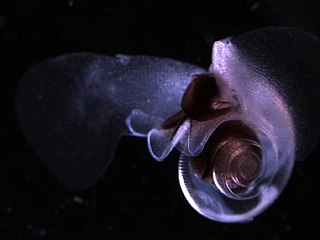
Sea butterflies, scientific name Thecosomata, are a taxonomic suborder of small pelagic swimming sea snails. These are holoplanktonic opisthobranch gastropod mollusks in the informal group Opisthobranchia. They include some of the world's most abundant gastropod species.

The Limacinidae are a family of small sea snails, pteropods, pelagic marine gastropod mollusks in the clade Thecosomata.

The superfamily Cavolinioidea is the most speciose group of sea butterflies. They belong to the suborder Euthecosomata.
The Notobranchaeidae, or "naked sea butterflies", are a taxonomic family of floating sea slugs, specifically under the subclass Opistobranchia, also called "sea angels".

The Pneumodermatidae are a family of sea angels, or small floating predatory sea snails or sea slugs. They are pelagic marine heterobranch opisthobranch gastropod mollusks in the clade Gymnosomata.

The Carangidae are a family of ray-finned fish which includes the jacks, pompanos, jack mackerels, runners, and scads. It is the largest of the six families included within the order Carangiformes. Some authorities classify it as the only family within that order but molecular and anatomical studies indicate that there is a close relationship between this family and the five former Perciform families which make up the Carangiformes.

Ophichthidae is a family of fish in the order Anguilliformes, commonly known as the snake eels. The term "Ophichthidae" comes from Greek ophis ("serpent") and ichthys ("fish"). Snake eels are also burrowing eels, they are named for their physical appearance, they have long, cylindrical, snake-like bodies. This family is found worldwide in tropical to warm temperate waters. They inhabit a wide range of habitats, from coastal shallows and even rivers, to depths below 800 m (2,600 ft). Most species are bottom dwellers, hiding in mud or sand to capture their prey of crustaceans and small fish, but some are pelagic.

Rasbora is a genus of fish in the family Cyprinidae. They are native to freshwater habitats in South and Southeast Asia, as well as southeast China. A single species, R. gerlachi, is only known from an old specimen that reputedly originated from Africa (Cameroon), but this locality is considered doubtful. They are small, up to 17 cm (6.7 in) long, although most species do not surpass 10 cm (4 in) and many have a dark horizontal stripe.

The superorder Elopomorpha contains a variety of types of fishes that range from typical silvery-colored species, such as the tarpons and ladyfishes of the Elopiformes and the bonefishes of the Albuliformes, to the long and slender, smooth-bodied eels of the Anguilliformes. The one characteristic uniting this group of fishes is they all have leptocephalus larvae, which are unique to the Elopomorpha. No other fishes have this type of larvae.

Crenimugil is a genus of mullets found in coastal marine waters and rivers in the Indo-Pacific region.

Halichoeres, commonly called wrasses, are a genus of fish in the family Labridae found in the Atlantic, Indian and Pacific Oceans.

Aspidorhynchiformes is an extinct order of prehistoric ray-finned fish that was described by Bleeker in 1859.

The family Cavoliniidae is a taxonomic group of small floating sea snails, pelagic marine opisthobranch gastropod mollusks.
The genus Clio is a taxonomic group of small floating sea snails, pelagic marine opisthobranch gastropod mollusks, the sole genus belonging to the family Cliidae

Tylosurus is a genus of needlefish, one of ten in the family Belonidae. They are found worldwide in tropical and warmer temperate seas and two species have been recorded as Lessepsian migrants in the eastern Mediterranean Sea.

The Anabantiformes are an order of freshwater ray-finned fish with two suborders, five families and having at least 207 species. In addition, some authorities expand the order to include the suborder Nandoidei, which includes three families - the Nandidae, Badidae and Pristolepididae - that appear to be closely related to the Anabantiformes. The order, and these three related families, are part of a monophyletic clade which is a sister clade to the Ovalentaria, the other orders in the clade being Synbranchiformes, Carangiformes, Istiophoriformes and Pleuronectiformes. This clade is sometimes referred to as the Carangaria but is left unnamed and unranked in Fishes of the World. This group of fish are found in Asia and Africa, with some species introduced in United States of America.

The family Hyalocylidae is a taxonomic group of small floating sea snails, pelagic marine opisthobranch gastropod mollusks.
Diacavolinia bicornis is a species of gastropod in the family Cavoliniidae.
Cuvierinidae is a family of gastropods belonging to the order Pteropoda.

Cavolinia is a genus of gastropods belonging to the family Cavoliniidae.















